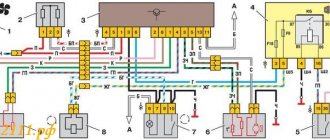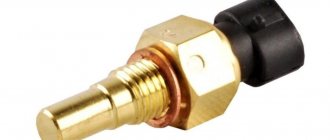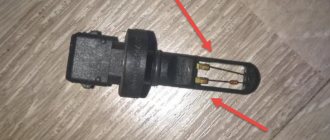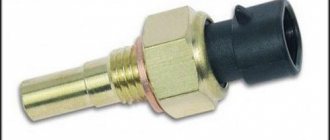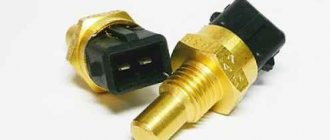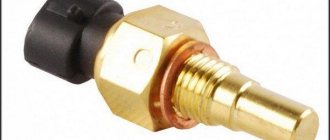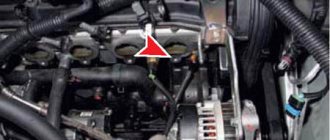Cars admin26.02.2020
1. Turn off the power to the car
2. Remove the front bumper of the VAZ 2172 (see “Removing and installing the front bumper of the VAZ 2171”).
3. Overcoming the resistance of the clamps, remove the sensor from the bracket...
4. ...press the clamp of the wiring harness block...
5. ...and remove the sensor from the Lada Priora.
6. Install the sensor and front bumper of the VAZ 2170 in the reverse order of removal.
| Manufacturer: | Lada Holding GMBH Vienna |
| Vendor code: | 2172-8121210 |
| Name: | Air temperature sensor VAZ 2170 Priora external 2172-8121210 |
| Department: | VAZ |
Pickup from a warehouse in Yekaterinburg
Payment upon receipt:
- Cash
- Transfer to card
- By bank card
- By invoice (for organizations with VAT)
Important. Before receiving the product, check its availability by phone or place an order on our website.
Delivery by courier in Yekaterinburg and nearby cities
- Payment in cash upon receipt of goods
- The cost of delivery within the city and nearby cities is 100-250 rubles
- Free delivery throughout Yekaterinburg for orders over 10,000 rubles.
- Please check with the RusAvto manager for delivery times and costs.
For minimum order and delivery costs, see the Delivery section.
| Minimum order | Cost of delivery | Free delivery from | |
| Ekaterinburg | 1000 | 150 | 6000 |
| Upper Pyshma | 3000 | 200 | 10000 |
| Berezovsky | 3000 | 200 | 10000 |
| Aramil | 3000 | 200 | 10000 |
| Revda | 5000 | 400 | 17000 |
| Pervouralsk | 5000 | 400 | 17000 |
| Polevskoy | 7000 | 500 | 26000 |
| Sysert | 7000 | 500 | 26000 |
| Novouralsk | 10000 | 600 | 34000 |
| Nevyansk | 12000 | 700 | 37000 |
| * does not apply to large spare parts and special goods. price | |||
Delivery by Russian Post
- Prepayment 30% of the cost of the goods (Cashless payment on invoice)
- The balance of the amount is cash on delivery upon receipt of your goods at the post office.
- Delivery services are paid by the recipient according to the current tariffs of Russian Post.
Main elements of the stove
Structurally, the Lada Priora stove is similar to the device installed in the VAZ 2110; let us highlight its features in the mechanical and electrical parts.
Mechanical part:
- Air exhaust distributor assembly. It consists of flaps for heating the lower part and windshield, a half-body on the left and right, and a drive lever for the flaps.
- Instrument panel trim with guide units provided in it.
- Ventilation ducts (located on the left and right). Connect oval windows and side deflectors.
- Heating nozzles for side windows.
- Ventilation deflectors (in the center and on the sides).
- Air duct for heating the “foot” area of the driver and front passenger.
- An air duct for heating the rear section of the car where the passengers are located.
- Spoiler.
- Air filter.
Electrical part:
- Air distribution gearmotor. Provides distribution of air flow to different areas depending on the selected mode.
- Temperature sensor. Fixed in the ceiling area for the most precise temperature control.
- Resistor (additional, additional). The rotation speed of the furnace fan depends on it. Fixed in the engine compartment.
- Heating device controller/control unit. Here the car owner sets the operating parameters of the device.
- Electric fan. Located in the engine compartment.
- Stove radiator (located inside the heating device).
- Heating damper motor reducer. Redirects air flow in the cabin.
Interior temperature sensor "Priors"
One of the signs of increased comfort of a car is the presence of climate control. This is no longer just an old-style heater that had a couple of modes. This is a device that has its own control computer model. It keeps the cabin at exactly the temperature that is most comfortable for the driver, which he sets from the control panel. And it independently reacts to changes. The cabin air temperature sensor (CAT) reports them to the control unit. Priora is also equipped with such a system.
Principle of operation
To understand the reasons why the stove in Priora does not work, you need to know the principle of its operation. The same system applies here as in the “tens”.
The air flow from the heater is directed to the distributor, where, taking into account the position of the dampers, it directs the air.
Car owners can choose one of three positions:
- Heated / defrostered windshield.
- Ventilation.
- Direction of flow to the feet of people in the rear sofa or front seats.
It is possible to select an intermediate position of the dampers, for example, to direct air to the windows and ventilation.
The position of the flaps changes independently by moving the handle on the main deflector panel. When the blowing/heating is turned on, the air flow is directed through the channels to the desired areas.
Each of these channels is placed separately, which eliminates the mixing of different air flows.
About installing the controller on Kalina
Let's figure out how to install an ambient temperature sensor on this car. "Kalina", unfortunately, often does not even have the necessary wires, so you will have to pull them into the cabin yourself.
To install, you need to remove the bumper and install the sensor, preferably in front of the radiator. There are only two wires - ground and signal. We hook the mass to the nearest bolt, for example from a horn. We tape the signal wire to the harness with tape, although it is more preferable to use plastic clamps. The most convenient way to bring it into the cabin is through a plug installed near the battery. We remove the tidy and connect the sensor. Usually it shows the temperature right away, you don’t even have to remove the terminals. Now you know where the ambient temperature sensor is located on VAZ cars.
Design flaws
The Lada Priora stove has a number of design flaws that manifest themselves already during operation.
Let's highlight the main points:
- Air is supplied to the side deflectors in any of the damper positions. For this reason, there may not be enough air in the legs.
- The presence of additional holes and insufficient quality of seals when connecting pipelines leads to poor flow.
- Poor channel smoothing leads to excessive noise in the air ducts.
Otherwise, the design of the Priora stove is well thought out and rarely causes complaints from users. The exception is those cases when the device ceases to perform its intended functions.
For example, a common problem is when the stove constantly blows cold air. In this case, the cause of the malfunction is the damper or radiator.
Initial diagnosis
Before taking more serious steps, it is necessary to conduct a preliminary diagnosis.
Take the following steps:
- Check the coolant level in the expansion tank. The coolant level should be between the minimum and maximum marks. If antifreeze constantly leaks, check the system for leaks. Inspect the pipes and tighten the clamps. Make sure that the oil level in the engine crankcase has not increased due to antifreeze entering through the cylinder block gasket.
- Start the engine and wait until it reaches the optimal temperature.
- Feel the thermostat. Look at the thick tubes that go from it to the car's radiator.
- Make sure that after the engine warms up, the upper pipe heats up. If it is cold, then the cause is a broken thermostat. In this case, you cannot do without replacing the device. The second explanation for why the stove is not working correctly is a broken cap on the expansion tank. Install a new one and check again how the heating system works.
- Check the cooling (heating) system for air. Let us immediately note that in a Priora, the appearance of an air lock is possible only when the antifreeze is depressurized or incorrectly filled. To fix the problem, warm up the car, turn the heater on to maximum, drive the front wheels up a small hill and periodically step on the gas. First remove the expansion tank cap. In this mode, let the engine run for 5-10 minutes.
- Pay attention to the fan operation. If it does not move air well, remove the cabin filter and make sure it is not dirty. If you have such suspicions, replace the device.
Priora coolant temperature sensor - checking the part
The standard coolant temperature sensor in the automotive electronic control system is designed to establish the temperature values of the power plant at the current moment of its operation.
The impulse emanating from this electrical device forces the on-board computer to set the required optimized number of idle speed control steps, while simultaneously regulating the supply of the fuel mixture.
The coolant temperature sensor itself is nothing more than an ordinary thermistor, i.e. a resistor whose resistance value is directly related to the change in the temperature value of the coolant.
This effect in electrical engineering is called “negative temperature coefficient” and means that as the temperature of the coolant (antifreeze) increases, the resistance value of the coolant temperature sensor drops.
An increased temperature value of antifreeze entails a reduced resistance value (70 Ohm + 2% at a temperature value of 130°C), and, accordingly, a decrease in temperature value implies an increased resistance value of the sensor with values of 100-700 Ohm ± 2% at a temperature parameter of - 40°C.
The operating principle of the coolant temperature sensor is as follows: the controller, as an actuator, sends a voltage supply signal with a value of 5 V to the device through a constant resistance integrated into the controller. This executive component calculates the temperature values of the coolant based on changes in voltage readings on a sensor with a variable resistance.
On an unheated motor, the voltage value is high; on an engine that has reached the temperature value of the operating operating mode, the potential difference parameters are low. Thus, if the power plant is not turned on, then the voltage on the temperature sensor has increased values; if it has reached the optimal operating temperature, the values are low.
When the coolant temperature sensor operates in the engine start mode, when the ignition system is initiated, the on-board computer transmits a signal to the electric fuel pump relay. This device, having received a command signal, generates the corresponding pressure value in the fuel line for supply to the injection system.
The on-board computer tests the pulse of the Priora coolant temperature sensor and sends a signal to supply the optimal volume of fuel and air masses.
When the vehicle's crankshaft rotates, the on-board computer initiates the creation of a fixed-type signal to fire the injectors, the pulse interval being related to the frequency of the signal supplied by the temperature sensor.
This interval will be longer when the engine is not warmed up and shorter when the power plant has entered operating mode.
Let's look at the location of the coolant temperature sensors in the Priora. It should be remembered that the two-contact temperature sensor is located between the cylinder head and the thermostat, while the single-contact temperature sensor is located on the dashboard.
Identified defects in the coolant temperature sensor in a Priora car include unstable contact and its loss in the internal cavity of the device and damage to the insulating layer. In other cases, the product is quite reliable if you monitor the condition of the supply wiring. There are times when the device produces incorrect information.
To check the temperature sensor using a tester, set it in ohmmeter mode to the output contact and the body of the product. When located in a room where the temperature is approximately 18-25 degrees Celsius, the resistance of the coolant temperature sensor should be in the range of 1.5-1.7 kOhm.
To measure the resistance of the device at different temperature positions on the output contacts of the device, you need to immerse this electronic gadget in heated water. When the water temperature decreases due to cooling of the liquid, we continue measuring the resistance values and, if the device is in working order, the resistance should increase.
To replace the temperature sensor, you will need basic plumbing tools and a set of wrenches. The procedure for replacing the coolant temperature sensor for Priora:
- Remove the negative wire from the battery terminal.
- Drain a little antifreeze from the radiator.
- We dismantle the air purification filter for comfort during work.
- Squeeze the plastic fastener.
- Disconnect the wiring connector from the Priora coolant temperature sensor.
- Using a wrench, slightly loosen the tightening of the DTOZH and unscrew it from the thermostat body.
- To install the coolant temperature sensor, you need to do all the above steps in reverse order.
- Pour antifreeze into the vehicle's cooling system.
At this point the procedure can be considered successfully completed.
Source: https://avtovx.ru/datchiki-vaz/datchik-temperatury-ohlajdaushey-jidkosti-priora-185/
Cold heater radiator (heater does not heat)
In driving practice, a common situation is when the Priora’s stove blows cold air instead of hot air.
Let us highlight the main reasons for this situation:
- Failure in the engine cooling system. The stove radiator is cold and does not give off heat. To check, touch the heater pipes, which should be hot. The explanation for the malfunction may be the radiator itself, for example, due to the fact that it is clogged and does not allow antifreeze to pass through.
- Dirty cabin filter. To check the version, dismantle the unit and check whether the stove is functioning or not.
- The gear motor has failed.
- Wedge or damage to the damper.
- Failure of the heating device controller.
- Damage to the temperature sensor installed in the car interior. To check this version, disable it for a while, and then check the operation again.
During long-term operation of the vehicle, dirt collects in the engine block on the pipes, which is subsequently spread throughout the system, thereby clogging the radiator honeycombs. The stove radiator is no exception, which also becomes dirty and begins to work worse.
In such a situation, do the following:
- Drain the antifreeze from the system.
- Remove the wiper arms.
- Remove the frill cover and move the noise shield to the side.
- Disassemble the stove body, discard the wires and remove the electric motor.
- Remove the heat exchanger by discarding the supply pipes.
- Clean or replace it.
Replacing the coolant temperature sensor Lada Priora
The Priora engine runs smoothly. The coolant temperature gauge arrow shows the driver that there is no reason to worry. From time to time, the fan on the radiator turns on, cooling the moisture coming from the engine jacket. Everything is fine. But who keeps order in this area? It is clear that there was a sensor involved.
How many coolant sensors are installed on the Priora?
You should immediately decide on the Priora, as on any “injection” car there are two systems independent of each other:
- Engine control system, electronic (ECM).
- On-board control system for standard devices.
The fact is that the Priora instrument cluster is not part of the ECM system. And the radiator cooling fans are subordinated to it. That’s why it turned out that there are two coolant temperature sensors on the Priora. One is for providing readings to the instrument cluster, and the other informs the on-board computer about the need to turn on the fan.
Attention! These devices are completely different and are not interchangeable!
Indicator for the indicator on the instrument panel
The operating principle of this sensor is to change the resistance when the internal element heats up. Passing through the indicator on the instrument panel, the current flows through a single wire to the device.
And here the principle of induction in coils comes into play. Simply put, the higher the resistance, the more the needle on the indicator rises, due to the circulating currents in the coil located inside the indicator.
POSSIBLE MALFUNCTIONS OF THE PRIORA COOLANT TEMPERATURE DISPLAY SYSTEM
Most motorists, having discovered that the engine temperature gauge needle does not rise, believe that it is necessary to change the sensor. However, you should first make sure that this is the case. After all, there are several reasons for this state of the panel:
- Failure of the pointer on the instrument board.
- Break in the wiring.
- Direct failure of the sensor.
Therefore, it is better to conduct a small check on your own.
LOCATION AND CHECKING SERVICEABILITY OF DTOZH
This device is located directly above the Priora flywheel housing. The sensor is embedded in the engine block near the thermostat. It is connected to a single wire with a female connector. The test method for this device is very simple. And it has been used by drivers for a very long time. You need to do this:
- Turn on the ignition.
- Disconnect the connector from the sensor.
- Connect the wire to the block body.
If the DTOZH itself is faulty, the indicator arrow will rise to its highest position. But if no changes occur on the instrument panel, then the reason must be looked for elsewhere. Maybe the circuit is broken, the pointer is broken, or the whole combination.
Fan doesn't work
If during the check it turns out that air is not entering the cabin at all, take the following steps:
- Check whether fuse F9 is good or not. It may have burned out, causing no voltage to be supplied to the device.
- Make sure the fan is working properly. In this case, try to repair it or replace it immediately.
- Change the resistance if it is causing the fan to not operate properly.
- Make sure the controller is working.
- Clean the fan. There are situations when the device becomes clogged, causing it to not work or making increased noise during rotation.
- The fan relay is burnt out. If none of the tips discussed above helped, check the relay, the appearance of which can be used to judge its serviceability. If something is burnt inside, this indicates the need for replacement. After this, the Priora stove fan should start working.
- We wrote about the cabin filter above.
If the remaining components of the Priora stove are functioning normally, the cause may be a failure of the temperature sensor.
Where is the ambient temperature sensor located?
On different brands of cars, the controller has a different location. This is due in most cases to the design differences of the machines. For example, on a BMW you can install a temperature sensor directly behind the bumper, but not on a VAZ.
However, understanding where the ambient temperature sensor is located is quite simple. You need to find its number in the electrical diagram, and that's all. In most cases, it is installed near the radiator, usually in front or behind it. But it happens that it is mounted on the side. The main requirement is the absence of temperature effects from the engine. The motor gets hot and affects the controller. He, in turn, will give incorrect testimony.
Control unit failure
The weak point of the Priora stove is the control unit (controller). The functions of this device include air distribution, creating airflow activity in different zones, as well as maintaining optimal temperature inside.
If the unit fails, the stove will also not function, because it will lose its control body.
Before replacing the controller, check the serviceability of the regulator installed on the front panel, because the control unit rarely breaks down.
To avoid wasting extra money, find a known-good controller, install it in place of the current one, and check that the furnace is working properly. If the heater still does not work, look for a breakdown elsewhere.
To check whether the gearmotor is controlled by the control unit, remove the latter. Find the brown and pink and green wires (they control the gear motor). Measure the voltage on them.
To do this, connect a multimeter to the wires in 20V mode. Turn on the ignition and turn the control to hot and cold modes.
In the hot position, the multimeter should show around 10V, in the cold position - minus 10V. Those. the gearbox is controlled.
If the wires are connected in a different polarity, the readings will be opposite.
Direct installation
As noted above, the VAZ ambient temperature sensor is not difficult to install. Especially if all connectors are provided by the manufacturer. The next step is purchasing a sensor. There is nothing complicated, we go to the car store and buy the thing we need. The most optimal location for the sensor is near the radiator. The mass can be thrown over the welded pin. The wires need to be pulled into the interior. How this will be done is up to you. The most convenient and shortest way is through the clutch plug. Of course, you can’t do without disassembling the instrument panel. We dismantle it and look for the 25th contact. It is precisely intended for the ambient temperature controller. Readings on the on-board computer usually appear automatically. If this does not happen, reset the battery terminal for 10-15 minutes. After this everything should work. The VAZ ambient temperature sensor costs a penny. Its installation does not take much time.
Only speeds 1 and 4 work
Often such a malfunction occurs when the stove switch gives a command only in the extreme positions. The cause of breakdown is often additional resistance, which reduces the rotation speed of the furnace device.
The resistor is a block where the fourth speed is direct and without retardation. The device is located in the heater housing on the left and is secured with a pair of screws.
In a situation where the first three positions do not work, and only the 4th one functions, the cause may be a broken resistor (mentioned above) or a failure of the heating and ventilation system control unit. The last malfunction is more common.
The elements responsible for the operation of the Lada Priora stove are shown below.
Their types and principle of operation
p, blockquote 12,0,0,0,0 —>
The operating principle of almost all outdoor air temperature sensors is the same. It is based on the effect of changing the resistance value of a semiconductor element depending on temperature. The temperature dependence of resistance for semiconductors is negative. This means that as the temperature increases, the resistance value decreases. For the VAZ sensor, the dependence table is as follows.
p, blockquote 13,0,0,0,0 —>
| Temperature, in degrees | Resistance, Ohm |
| -40 | 100922,67±2,96 |
| -30 | 53046,93±2,49 |
| -20 | 29092,08±2,13 |
| -10 | 16567,33±1,68 |
| 9773,24±1,21 | |
| +10 | 5953,85±1,73 |
| +20 | 3737,33±2,11 |
| +30 | 2411,98±2,39 |
| +40 | 1594,92±2,65 |
As can be seen from the table, the values are given with an error. Such great precision is necessary to ensure high reliability of the readings. Temperature measurement belongs to the field of measuring technology, and it should not “lie”. At manufacturing plants, selective verification of devices is carried out. It is doubtful that they do this in China, but Russian sensors accurately check. They “verify”, not “check”. Verification is a term used by surveyors and the military.
The stove does not turn on
In a situation where the Priora stove does not turn on, there may be two explanations - a blown fuse, a blown fan motor, a breakdown of the controller, or oxidation of the contacts in the connectors.
After checking the fuse, take the following steps:
- Open the hood and on the left side (looking at the windshield) remove the rubber seal at the top left.
- Remove the four screws to remove the trim.
- Find the heater connector somewhere near the third mount.
- Turn on the ignition.
- Try to press the connector and pay attention to whether the stove starts working or not.
Damage to the connector is a real problem on the Priora, so do not rush to immediately change the control unit or other elements before checking the fuse and the quality of the contact connection.
Where is the outside air temperature sensor located in a car?
p, blockquote 23,0,0,0,0 —>
The choice of location of the sensor is determined by considerations of minimal exposure to moisture, dust, dirt, water from oncoming air flows, and limiting the influence of the vehicle’s own heat sources. This is usually somewhere just behind the bumper or in the side rearview mirror.
p, blockquote 24,0,0,0,0 —>
Video - outside air temperature sensor on PRIOR:
p, blockquote 25,0,0,0,0 —>
p, blockquote 26,0,0,0,0 —>
If you install the outdoor temperature sensor yourself, you must also follow these principles. If there is no housing for the sensor, you must make it yourself. A device installed without a protective housing will not provide accurate readings.
p, blockquote 27,0,0,1,0 —>
Removing the stove control unit
Car owners have many difficulties when removing the heater control unit.
Take the following steps:
- Open the cover on the center console.
- Remove the screws on the left and right.
- If a radio is installed, remove it and unscrew two more screws at the top on both sides.
- Discard and take out the ashtray.
- Unscrew the fastening screws from the bottom.
- Pull the console towards you and remember that it is latched. Please note that it will not be possible to completely remove the device, because the wires are connected to it.
- Disconnect the connectors that are connected to the device.
- Press the other side of the button until it comes out.
- Press the latch and remove the device.
- Press the clamp and throw the wires away from the heater control unit.
- Remove the device itself.
After this, you can perform replacement or repair depending on the current situation.
Where is it located and how is it removed?
VAZ designers placed the DTVS module in a very original way. It is located in the plastic housing of the interior lighting unit. Directly under the rearview mirror. Under two backlights for the driver and passenger, you can see the air intake holes for supply to the combustion engine.
The module is dismantled quite simply. First, the rearview mirror is removed.
After this, two bolts are opened that secure the light module to the body and upholstery. They are simply unscrewed with a screwdriver or hexagon, depending on the type of bolts. When this unit begins to separate, it becomes possible to disconnect the wire connectors from the Priora interior air temperature sensor and directly from the backlight unit.
The DFA itself is a plastic box secured to the module body with two screws. And a wiring harness with a connector coming out of it. By unscrewing these bolts, you can freely separate the diesel fuel assembly.
And when the node is removed, various actions can be carried out with it. But most often, this is simply cleaning and lubricating the fan. Or replacing one of the nodes.
Although practice shows that most often drivers prefer, without bothering too much, to simply replace the complete combustion engine assembly. It’s really simpler, since its cost is not so high. Around 400-500 rubles.
And installing a new one according to the description above, proceeding in the reverse order, is generally not difficult.
And you can watch a short video on this issue:
3A%2F%2Fi.lada-forum.ru%2Fpublic%2Fstyle_images%2Fmobile%2Fprofile%2Fdefault_large.png" /% max497 Nov 22, 2010
In Kalinas with air conditioning (although there are also ones without air conditioning), a cabin temperature sensor is installed in the lighting ceiling so that fresh air constantly flows in; a small fan is installed there. Everything does not last forever and over time this fan begins to produce unpleasant sounds: rustling, noise, rattling, whistling, etc. This is especially often reflected in those who constantly keep the cabin fan on at a given temperature. There is no point in repairing this fan; the easiest way is to replace it together with a temperature sensor.
Blows constantly hot
Another situation that may arise when using the Priora stove is that it is not possible to regulate the temperature, and only hot air comes out of the system. Turning the regulator does not give any result.
In this case, do the following:
- Measure the voltage at the control unit (see above).
- Measure the voltage at the MMR (gear motor).
- When switching to maximum and minimum voltage, 30 V of a certain polarity appears, and then drops to 0.
- If the quiescent voltage is not 0, but is about 5 V, then the fault concerns the control unit.
- In the case when the voltage is not normal and the damper does not change position, it is necessary to change the MMR.
Where is the temperature gauge sensor on the needle located on the Priora and the symptoms of its malfunction
To check the temperature gauge sensor on a Priora or replace it, you must dismantle it. To do this, you should first understand the location of the device. The temperature indicator sensor is located on the needle on the Priora next to the DTOZH. If the DTOZH is built into the thermostat housing, then the DTOZH is installed directly in the cooling system on the engine block (under it on the left, as shown in the photo below).
To get to this sensor, you need to remove the air filter housing.
Signs of malfunction of the product in question appear as follows:
- The pointer arrow freezes in its initial position.
- The arrow shows incorrect values, for example, when the engine is warm, it shows 50-70 degrees, although it should be around 100 degrees.
- There is an abrupt change in readings, for example, the needle jumps from 90 degrees to 70 or 50, and returns back.
- Set at a maximum of 130 degrees.
Having an idea of the location of the element, you can resort to replacing it, and this process is described in detail in the next section.
Priora stove with air conditioning does not work
The situation is different when the car has air conditioning. In this case, incorrect operation is due to a breakdown of the speed control unit. Its functions include adjusting the operation of the electric fan motor.
If the radio frequency control malfunctions, the stove stops working altogether and performs its functions only at the last (fourth) speed.
Most often, the breakdown is explained by prolonged operation of the heater in recirculation mode and, as a result, overheating. That is why the serviceability of this device also needs to be checked.
Well, the other breakdowns described above have not been canceled.
The heater doesn't heat up at idle
Another problem that car owners face is problems with the kidney idling.
In this case, there are several reasons for the malfunction:
- Low level of antifreeze in the cooling system.
- Leaks that lead to the situation described in paragraph 1.
- Airiness of the system.
The first two problems are rarely difficult to solve. The situation is different when the malfunction is caused by an air lock.
Take the following steps:
- Remove the screen from the motor.
- Loosen the clamp, then remove the throttle assembly heating tube and select any of the options.
- Unscrew the cap of the expansion tank.
- Place a clean rag on the neck and start blowing until coolant comes out of the removed pipe.
- Place the tube onto the fitting and tighten the clamp.
- Put the screen back in place.
If the considered method does not solve the problem, go through the following steps:
- Warm up the engine to increase the pressure in the system.
- Turn off the car and remove the tube from the throttle heating. In this case, there is no need to remove the plug from the cooling system tank.
Due to the high pressure, excess antifreeze will come out through the tube. Next, all that remains is to insert the tube into the fitting and tighten the clamp.
Coolant temperature sensor on Priora 16 valves
The Priora 16-valve coolant temperature sensor is no different in design from the 8-valve one. Essentially, these are the same device that measures the temperature of antifreeze.
A distinctive feature of the Priora is the presence of two detectors that are not connected to each other. One works only with the dashboard, transmitting measurement data to it, while the other coordinates its work with the brains of the car. Together with them, ensuring uninterrupted engine operation by turning on additional cooling systems if necessary.
The detector operates based on the principles of resistance. Being a thermistor, the device's resistance values are directly related to changes in coolant temperature.
Based on the readings of this meter, among other things, the on-board computer makes a decision on the supply of air and fuel to the engine.
That is why when they talk about a malfunction of the DTOZ, they also talk about increased fuel consumption.
What problems arise?
The coolant temperature sensor in the Priora 16 valves, as already mentioned, is no different from others, and therefore has the same problems, methods of treating and diagnosing them.
In the event of a malfunction of the detector communicating with the instrument panel, the only signal about this will be a missing or deliberately incorrect temperature value. The cause of the malfunction may be:
- breakdown of the indicator itself on the tidy;
- wiring fault;
- failure of the detector itself.
As can be seen from the list, the breakdown is not always caused by the meter itself, but as practice shows, much more often problems arise with the wiring. It is worn out or dirty.
Malfunctions in the operation of the second meter are more significant. Despite the fact that the causes of the malfunction remain the same, the ways to notice the malfunction are completely different and have a whole list of symptoms:
- increased fuel consumption;
- the engine stalls and may not start immediately;
- car power drops;
- You can hear the hum of constantly running fans of the propulsion system.
The Priora coolant temperature sensor is located above the flywheel housing and is inserted into the engine block near the thermostat. It is from there that it is necessary to begin checking the malfunction by inspecting the electronic cable and “ringing” its contacts.
To make it easier to work with the detector, it is best to remove the pipe connecting the air filter and the throttle assembly.
After checking all the contacts, you can start working with the meter itself, and for this you should already turn off the power to the car and be sure to drain the antifreeze.
If the antifreeze is not drained in advance, then when you unscrew the meter, it can come out on its own under pressure, and it will be good if it does not turn out to be hot at that moment.
After all the preparations, you can start removing it; to do this, you just need to disconnect the wires from the meter along with the terminal, and unscrew it using a 19mm deep socket. As soon as the meter moves in, you can then unscrew it and remove it by hand.
The old detector can be cleaned and tested in a glass of heated water. However, if you don’t have the necessary equipment or desire, you can simply insert a new meter and check how everything works. If it works, it means the detector was faulty, and there is no point in bothering with its diagnostics.
Since even if his death is accurately established, it still cannot be repaired and you will have to purchase a new device. And if there is no way to cure the patient, then there is no rational point in diagnosing him, except to satisfy his curiosity and the hope that after cleaning he suddenly came to life.
Types of water temperature sensors
A new detector costs practically nothing, and losses from untimely repairs grow every day like a snowball. Don't neglect your safety and the optimal performance of your vehicle.

